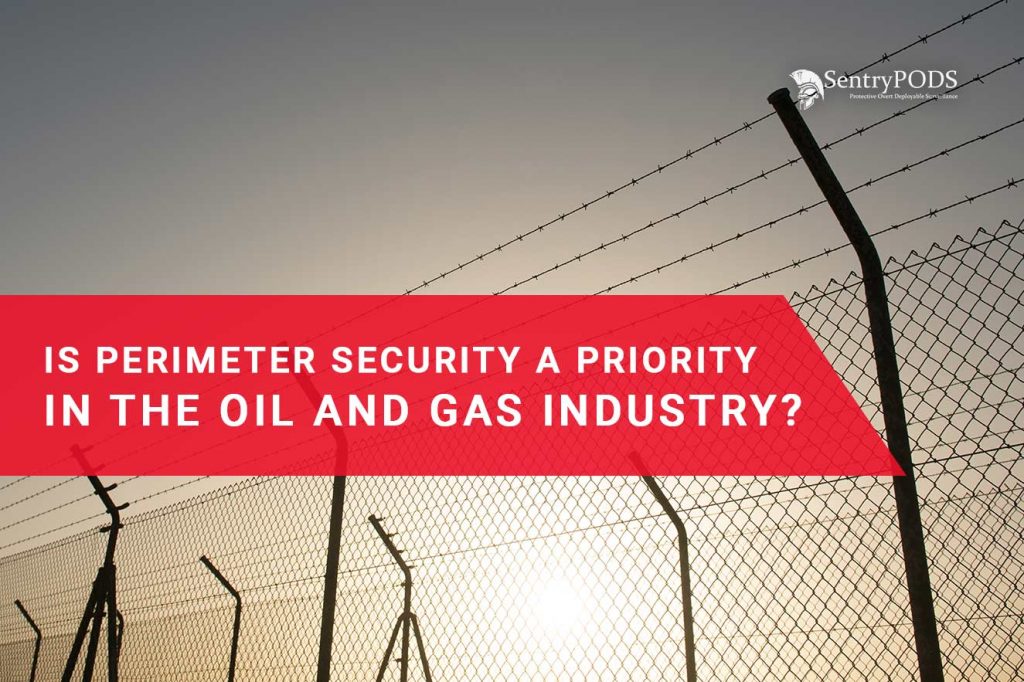Is Perimeter Security A Priority In The Oil and Gas Industry?

Securing the perimeter of oil and gas infrastructure is critical, but also very complex – as the security needs of each site vary within the upstream, downstream, and midstream sectors of this industry. For example, protecting an offshore oil rig requires a different approach to perimeter security than a pipeline or refinery will require. Knowing the specific needs of each oil and gas location for perimeter security is essential to assessing and preventing potential risks associated with oil and gas production, and securing the critical infrastructure of these individual sites. With that being said, the need for critical infrastructure surveillance continues to grow.
The Oil and Gas Industry By Sector
The Oil and Gas Industry is made up of three different sectors: upstream, downstream, and midstream. Upstream oil and gas production is conducted by companies that identify, extract, or produce raw materials and include oil rigs and wells. Downstream oil and gas production companies are involved in the post-production of crude oil or natural gas and include refiners. The midstream sector includes the transportation and storage of materials from rigs or wells to storage and distribution facilities, and includes pipelines and tank farms. Each sector has its own security threats, which need to be taken into consideration when designing a comprehensive security system for the perimeter.
Securing the Upstream Sector’s Assets
There are many potential security risks that can impact the operations of an oil or gas rig. These include any small boats or ships that might be in the vicinity of the rig, as well as swimmers who might approach the rig. A security system that protects the perimeter of an oil or gas rig needs to be able to track and identify bad actors before they breach the perimeter. Long-range, high-tech devices that track various targets and proactively identify them early on are beneficial in this environment. To do this, you will need:
- Long-range thermal cameras that feature panoramic scanning and automatic detection of intruders. They also can scan the perimeter non-stop, meaning that there is no gap in surveillance, and security personnel can be alerted to any and all threats instantly.
- Cameras manufactured from durable materials that are suitable for a maritime environment.
- Cameras that integrate with your existing security systems and can use existing networks securely.
Oil and gas wells require different security measures than oil or gas rigs, including:
- Perimeter fencing to discourage bad actors from approaching the site.
- Rugged cameras, mounted at strategic points to provide overlapping views of the perimeter and infrastructure itself.
- Networked, integrated sensors that detect intruders and alert security personnel immediately.
Making Security a Priority For The Midstream Sector
Oil and Gas pipelines are vulnerable to theft and sabotage, with a single incident liable to cause property destruction, service interruptions, and risk to human life. The theft or vandalism of equipment can lead to environmental damage, while leakage from a section of pipeline can have very serious consequences. For this reason, consistent pipeline monitoring and security is critical. Consider these qualities when installing a security system along your pipeline perimeter:
- Remote video surveillance to allow 24/7 access to perimeter views.
- Solar-powered cameras that do not depend on the grid to function, and that are designed for remote locations.
- Night-vision cameras to monitor activity day and night.
- Motion activated systems that measure changes in thermal activity and trigger each camera to capture video clips when a human or vehicle is present in the viewing area.
- Surveillance cameras that integrate with existing technology and allow for secure, integrated data transmission to a remote monitoring center.
Downstream Perimeter Security in the Oil and Gas Industry
Oil and gas refineries are often targeted by criminals. These large facilities are highly complex in terms of security, and require strategic solutions to secure the perimeter. In recent years, thermal imaging systems have gained in popularity for these types of facilities. These systems are capable of operating in complete darkness, extreme weather scenarios, and near-zero visibility. Most have high-resolution capabilities over the medium to long-range spectrum, and are capable of integrating with existing networks to keep cost low. Audio technologies, like loudspeakers used to broadcast automated warnings to people entering restricted areas or live talk-downs by operators to unauthorized people seen near the plant’s perimeter are also effective security measures for oil refineries and tank farms.
A Final Note On The Oil and Gas Industry’s Perimeter Security
Due to their remote nature, the critical assets of the Oil and Gas Industry are particularly at risk from physical threats. Effective perimeter security means multi-level network surveillance in conjunction with active deterrence solutions like audio and illumination, operating 24/7. From oil or gas rig to refinery, and everything in between, scalable intrusion protection is an essential part of ensuring Oil and Gas Infrastructure. Secure, networked video surveillance in combination with physical barriers will allow for a complete and robust perimeter security strategy that safeguards your critical site from physical as well as cyber attacks.
Click here to learn more about the SentryPODS technology that can secure your oil and gas infrastructure sites.

Brent Canfield
CEO and Creator of SentryPODSBrent Canfield, CEO, and founder of Smart Digital and SentryPODS, founded Smart Digital in 2007 after completing a nine-year active-duty career with the United States Marine Corps. During the 2016 election cycle, he provided executive protection for Dr. Ben Carson. He has also authored articles for Security Info Watch.

